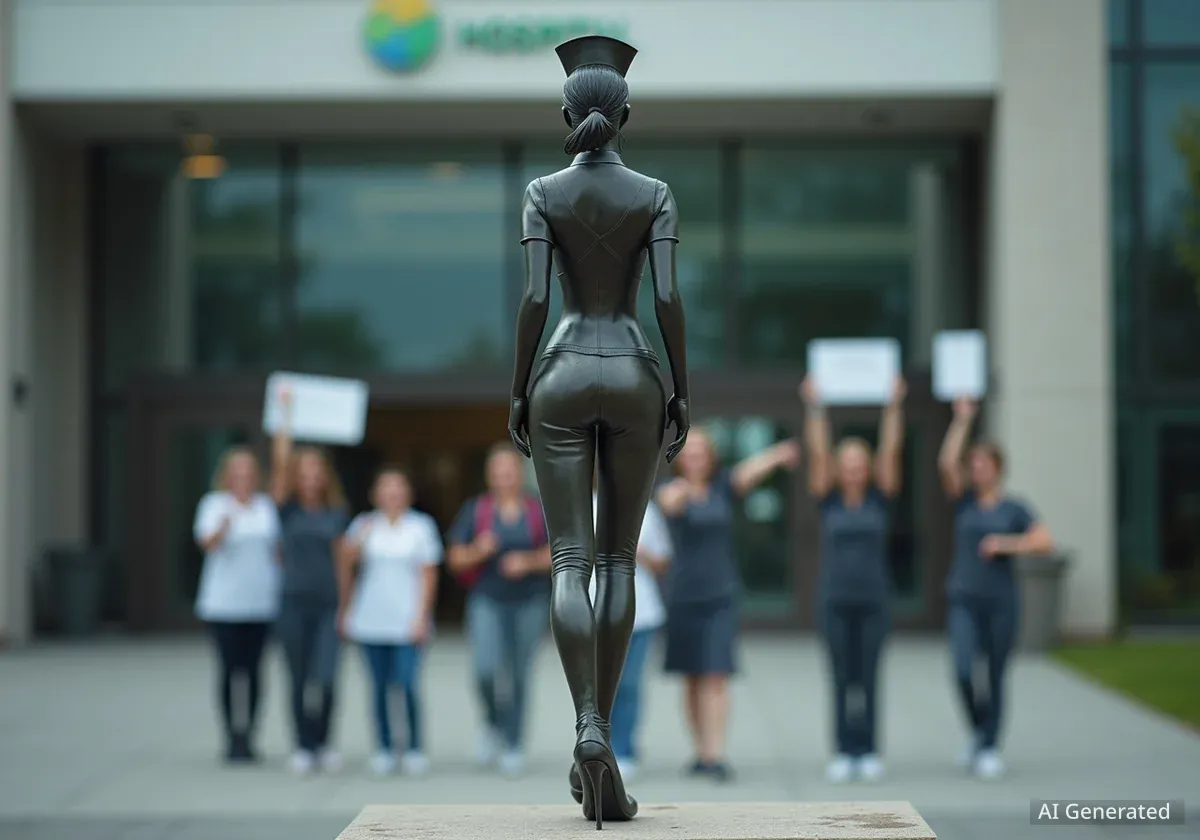Medical workers in Poland are calling for the removal of a statue depicting a nurse outside a hospital in Zielona Góra. The sculpture, which features a figure in a short skirt, low-cut dress, and high heels, has drawn strong criticism from nursing organizations who describe it as sexist and demeaning to the profession.
The statue, named "Zdrowitka" (Healthy Woman), was intended to honor the hundreds of nurses, midwives, and female staff at the University Hospital. However, its design, which its creator said was inspired by the video game character Lara Croft, has sparked a national debate about the portrayal of medical professionals.
Key Takeaways
- Polish nurses demand the removal of a statue deemed sexist.
- The sculpture, "Zdrowitka," is located outside University Hospital in Zielona Góra.
- Critics state the statue's design sexualizes nurses and undermines their dignity.
- The sculptor defended his work as witty and satirical.
- A petition has been launched to support the statue's removal.
Controversial Design Draws Widespread Criticism
The small figurine stands outside the University Hospital in Zielona Góra. It shows a woman in high heels and a short, low-cut dress, holding an oversized syringe. This depiction has caused significant offense among the nursing community.
The statue is one of 79 miniature "Little Bacchuses" found throughout Zielona Góra. These statues are a local tradition, similar to the gnomes in Wrocław. Their name references Bacchus, the Roman god of wine and revelry, honoring the city's winemaking history. Sculptor Artur Wochniak, who created many of these figures, including Zdrowitka, intended them to be witty and satirical.
"If there's a sculpture at the hospital entrance, symbolizing a nurse in this uniform, what should patients expect on the wards?" stated Elżbieta Baliszewska, chairwoman of the District Chamber of Nurses and Midwives in Zielona Góra, expressing her organization's demand for the statue's removal to TVN24.
The statue gained nationwide attention immediately after its unveiling on a recent Friday. The District Chamber of Nurses and Midwives in Zielona Góra quickly voiced its opposition.
Sculptor's Intentions and Public Reaction
Artur Wochniak described his creative process. He aimed for a "Lara Croft-type warrior" but with a syringe instead of a gun. He also wanted her to be "cool, pretty, beautiful," and "a little sexy, like most of my bacchantes."
However, this inspiration did not resonate with the medical community. Marzena Żołądziejewska, spokesperson for the District Chamber of Nurses and Midwives, explicitly stated, "I don't like the sculpture. It's so frivolous, sexist, and nasty.”
Fast Fact
- Zielona Góra has 79 "Little Bacchuses" statues across the city.
- The statues honor the city's historical winemaking traditions.
- The name "Bacchantes" refers to female followers of Bacchus, the Roman god of wine.
Hospital and Artist Defend the Artwork
Despite the backlash, the hospital's president and the sculptor have defended the statue. Dr. Marek Działoszynski, President of University Hospital, described Zdrowitka as "sensational." He explained that the idea for the statue came from marking the 80th anniversary of the Bacchantes tradition.
Dr. Działoszynski told the lubuskie.pl website that "The Bacchante is not a sad nurse, but a playful, artistic accent. It is a sculpture intended to delight and entertain."
Wochniak also maintained that the Bacchantes figures are inherently satirical. He believes his creation fits within this artistic tradition, aiming to be lighthearted rather than offensive.
Background on Bacchantes
The Bacchantes tradition in Zielona Góra involves small, whimsical statues placed around the city. These figures often depict playful characters related to wine culture or local themes. They are part of the city's identity, similar to the gnomes in Wrocław, and are generally seen as humorous public art.
Petition Launched for Statue's Removal
In response to the controversy, a petition has been launched calling for Zdrowitka's removal. The petition's organizers argue that the figurine sexualizes nurses and perpetuates harmful stereotypes. They highlight that it undermines the dignity of female medical staff, who often face harassment and disrespect in their daily work from both patients and colleagues.
The petition's explanatory text strongly criticizes the statue's placement. It states, "Placing a statue in front of a hospital, associated with cabaret or erotica, is a symbolic slap in the face to all medical staff."
On Friday evening, following the public outcry, the statue was covered in white bandages from head to knee. This act likely represents a form of protest against its controversial depiction.
The debate continues to highlight broader concerns about how the nursing profession is perceived and represented in public spaces. Many believe the statue's design trivializes the serious and demanding work performed by healthcare professionals.
This incident reflects a growing awareness of gender representation in public art and the importance of respecting professional identities. The nurses' organization remains firm in its stance, pushing for the statue to be permanently removed from the hospital grounds.




